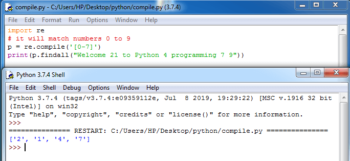
Let’s write a simple python program to understand the re.findall() function’s behavior. If the pattern is not found in the text, re.findall() returns an empty list. In contrast, the re.findall() function iterates over all the lines of the file and returns all the non-overlapping matches of pattern in a single step. The re.search() method quickly searches the provided text using the specified pattern and returns only the first occurrence. In Python, the re.findall() method returns a list of strings containing all the matching cases from the input text upon provided pattern. Therefore, it returned positive and negative for the second case.

For the first case, the function got a matching case. I set two patterns in the above python program and searched them into my_string.

Looking for 'Dan' in 'Software testing is a tough job' Not a match Output: Looking for 'Software testing' in 'Software testing is a tough job' Here is a match case Print("Looking for '%s' in '%s' " % (pattern, my_string), end='') My_string = "Software testing is a tough job" Here is a simple example for your better understanding. The Python re.search() function returns a match object when the pattern is found and is " null” if the pattern is not found in the string. Unlike the re.match() function, it checks all lines of the input string. The re.search() function searches for the regular expression pattern and returns the first occurrence in a string. As you can see, we get an output of None because it didn't find the pattern at the beginning of the first occurrence. Else it returns None if the string does not match the given pattern. In the above example, the function re.match() returns a corresponding match object if zero or more characters (C) at the beginning of the string match the pattern. Print("Sequence 2: ", re.match(pattern,sequence2).group()) Print("Sequence 1: ", re.match(pattern, sequence1)) Please allow me to show you a quick example now. However, if a match is seen in another line, the Python RegEx Match function returns null. Therefore, if a match is found in the first line, it immediately returns the matched object. The Python RegEx Match function checks for a match only at the beginning of the string. The re.match() function of the re module in Python searches for the regular expression pattern and returns the first occurrence. In this tutorial, I’m going to discuss the three most practical and widely used functions. The RegEx mechanism comes with the module named re, and it provides many functions. The basic syntax of importing the RegEx module is: import re Python comes with a module named re to work with RegEx. With time and training, you will understand the uniqueness of these characters and learn when to use them. Don't bother if you can't wrap your head around all the meta-characters for now. Note: The above table doesn't shed light on every aspect of RegEx. Scrutinizes if the preceding character appears zero or more times.Ĭreates a named group when performing matches. It matches up only the beginning or end of the word.Ĭhecks if the preceding character appears single or multiple times. It matches any character that is not a decimal digit. It matches up any character that is not a part of s. Matches up a single whitespace character like space, newline, tab, return.

It matches any single letter, digit, or underscore. Used to drop the special meaning of character following it It matches the set of characters you specify within it. It matches up only at the end of the string. It matches up only at the start of the string. Matches up a pattern at the start of the string. Matches up any single character except the newline character. To know more about RegEx syntax, you may check the Official Documentation. Let me introduce some fundamental metacharacters in RegEx and their purpose of use. Today our quest is to find out the importance of RegEx in the context of development with some simple and relevant examples. In the programming world, both newbie and experienced developers often ask how vital learning RegEx is. While you are using the Regular Expression in Python, the first and foremost thing is to understand that everything is a character, and you are reproducing patterns to match a specific sequence of characters also regarded as strings. This article sheds light on the usage of Regular Expression using Python. In simple words, RegEx is a combination of letters, symbols, and numbers you can use to search for things within a longer text. Regular Expression is beneficial for extracting information from text such as code, files, logs, spreadsheets, or even documents. RegEx is a unique text string used for defining a search pattern. In Python, Regular Expressions are also known as RegEx.


 0 kommentar(er)
0 kommentar(er)
